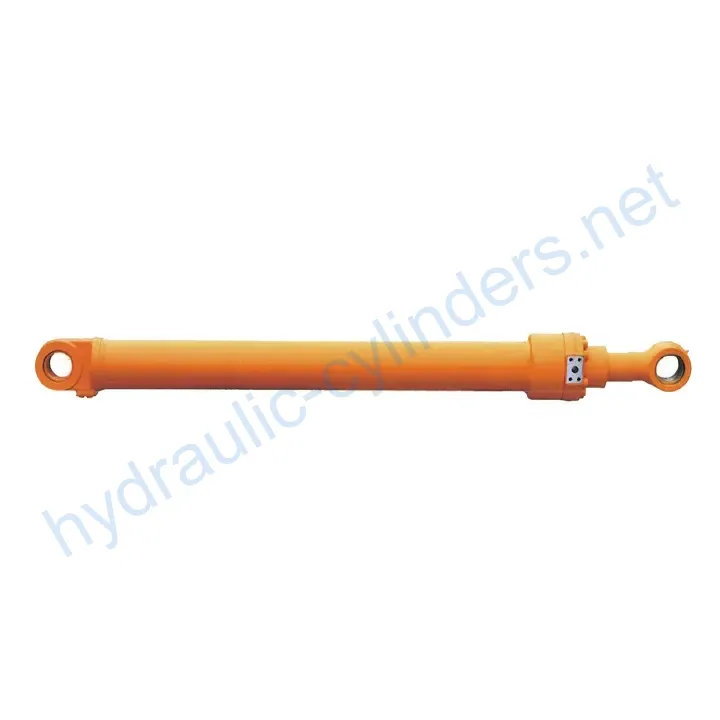Arm Cylinder For Yanmar SV100
Fiind unul dintre producătorii, furnizorii și exportatorii de cilindri hidraulici, oferim cilindri hidraulici și multe alte produse.
Vă rugăm să luați legătura cu noi pentru detalii.
Mail:sales@hydraulic-cylinders.net
Producător, furnizor, exportator de cilindri hidraulici.
Arm Cylinder For Yanmar SV100
Product Definition
The Arm Cylinder for Yanmar SV100 is a specially designed hydraulic cylinder that provides linear motion and power to the arm of various machinery, such as excavators, cranes, and robotic arms. The arm cylinder plays a crucial role in hydraulic systems, allowing for efficient movement and control of additional tools or attachments. These cylinders not only ensure smooth motion but also withstand heavy loads, ensuring efficient operation and reliability of the machinery under various working conditions.

Product Features
-
High Efficiency Transmission
The arm cylinder provides powerful linear motion and force, ensuring high-performance capabilities for the robotic arm in various operations.
-
Precise Control
Through the hydraulic system, the arm cylinder enables precise motion control, making operations of the additional tools more flexible and accurate.
-
Durability
The arm cylinder is typically manufactured using high-strength materials, offering excellent wear and corrosion resistance, making it suitable for long-term use in harsh environments.
-
Multi-functional Adaptability
These cylinders can be widely used in various machinery equipment, such as excavators, cranes, and robotic arms, catering to different operational needs.
-
Easy Maintenance
Designed with consideration for easy maintenance and replacement, the arm cylinders facilitate convenient regular inspections and maintenance, reducing equipment downtime.

Application Scenarios
-
Construction Engineering
In excavators and cranes, the arm cylinder controls the movement of the bucket or boom for earthwork, material handling, and structural installation.
-
Manufacturing Industry
In automated production lines, the arm cylinder is used for the motion of robotic arms in assembly, welding, and handling processes, improving production efficiency and precision.
-
Agricultural Machinery
In agricultural machinery such as harvesters and seeders, the arm cylinder controls the movement of operating arms for tasks like seeding, fertilizing, and harvesting.
-
Mining
In mining equipment, the arm cylinder controls the arm movement of mining machinery for ore extraction and transportation.
-
Logistics and Transportation
In forklifts and handling robots, the arm cylinder is used to control the lifting and movement of forks, enabling material handling and stacking.
Design Considerations and Selection Criteria
Load-Bearing Capacity
The arm cylinder is designed to withstand various loads and forces, ensuring safe and efficient operation without structural failure.
Sealing
Various sealing elements, such as piston seals and rod seals, are used to prevent hydraulic fluid leakage and maintain optimal performance. These seals are made of wear-resistant materials like polyurethane and nitrile rubber.
Durability
The cylinder body and threaded ends are finely processed to enhance wear resistance. The materials used are selected for their durability and ability to withstand harsh conditions.
Safety
Design considerations prioritize safety features such as pressure relief valves and emergency stop mechanisms to ensure the protection of operators and machinery.
Maintainability
The design of the arm cylinder takes into account ease of maintenance and replacement, making regular inspections and servicing convenient and reducing downtime.

Sealing and Lubrication
Various sealing components, such as piston seals and rod seals, are used in the arm cylinder to prevent hydraulic fluid leakage. These components are made of wear-resistant materials such as polyurethane and nitrile rubber. The cylinder body and threaded ends are finely processed to improve wear resistance. Regular lubrication with the appropriate amount of hydraulic oil is required to ensure smooth operation.
Regular Inspection and Preventive Maintenance
-
Perform visual inspections regularly
Check for any signs of leakage, damage, or wear, and take appropriate action if necessary.
-
Clean the cylinder and its components
Remove any dirt or debris that may affect the performance and lifespan of the arm cylinder.
-
Monitor fluid levels
Ensure an adequate supply of hydraulic oil and check for any contamination.
-
Tighten loose connections
Inspect and tighten any loose fittings, bolts, or nuts to maintain the stability and integrity of the arm cylinder.
-
Follow manufacturer’s maintenance schedule
Adhere to the recommended maintenance intervals and procedures provided by the manufacturer to ensure optimal performance and longevity.

Product Installation Guide
Proper installation of the arm cylinder is crucial to ensure its functionality and longevity. Follow the steps below:
- Prepare the mounting area and ensure it is clean and free from debris.
- Position the arm cylinder in the desired location and align it with the mounting points.
- Securely fasten the cylinder using appropriate bolts and fittings.
- Connect the hydraulic hoses to the cylinder, ensuring proper alignment and tight connections.
- Check for any leaks or abnormalities in the hydraulic system before operation.

Safety Considerations and Environmental Factors
When using the arm cylinder, it is essential to prioritize safety measures to prevent accidents and ensure the well-being of operators. Adhering to safety protocols and providing adequate training to personnel handling the equipment is crucial. Additionally, considering environmental factors, such as proper waste disposal of hydraulic fluids and adherence to environmental regulations, is essential to minimize any negative impact on the environment.
Troubleshooting and Common Issues
Common issues with the arm cylinder may include:
- Leakage of hydraulic fluid
- Reduced or uneven arm movement
- Excessive noise during operation
- Unresponsive controls
- Increased resistance or stiffness
To address these issues:
- Check for any damaged seals or fittings and replace them if necessary.
- Inspect the hydraulic lines for any blockages or leaks and address them accordingly.
- Ensure proper hydraulic fluid levels and replace or refill as needed.
- Inspect control valves and connections for any malfunctions or damage.
- Clean and lubricate moving parts to reduce resistance and stiffness.

By following these troubleshooting steps and implementing preventive
Faceți un tur al fabricii noastre VR:
Faceți un tur al fabricii noastre VR cu următoarele
Cilindru hidraulic Aplicație:


